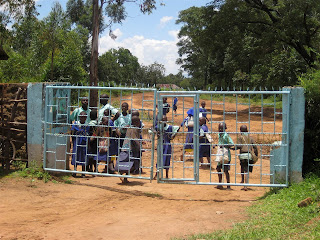
It's been a week since I left Kenya. Each day my minds drifts back to ten joyous days in Kakamega where I felt absolutely and fully alive. I cannot recall a time in nearly four decades as an educator when students I interacted with were more focussed and engaged in their learning.
What I saw were teachers whose actions truly were impressive. What teachers and principals do on behalf of their students with so little is truly astounding. To teach is to love, for there is none that teaches for material gain.
Teachers in Lurambi District give their time and their skills for very little in return. Dedicated to their profession, they exhibit the fundamental principles of love for their students and for their community.
I Corinthians 13 is a well known passage from the New Testament Bible. The fundamental concepts which elevate the teaching profession to that of sacred is clearly outlined in this passage about love. The themes of Relationship, Relevance and Inspiration are beautifully expressed in this paraphrase:
“If I speak with human eloquence but don’t love
I’m nothing but the creaking of a rusty gate
If I display huge talent and much knowledge but don’t love
I am nothing but a bag of empty rhetoric
If I give everything I have to the needy but I don’t love
I really am nowhere; in fact,
without love I am bankrupt
Love never gives up
Love cares more for others than for self
Love doesn’t strut or have a swelled head
Love doesn’t keep score of the failings of others
Love takes pleasure in the flowering of truth
Love always looks for the best
Love never looks back, but keeps going to the end
Love never dies
At the end of the day
There are three things that stand alone
Faith, Hope and Love
The greatest of these is Love”
To teach is to love and to love is to hope that the world can be a better place. This is the dream that must never die.
I have a dream that one day every child in Kakamega will not fear the onslaught of malaria and diarrhoeal disease. I have a hope that HIV among adult men and women aged15-49 will be erradicated and that all will know their status as well as they know their name. I have a vision that polio will be a distant memory from another generation. I see a day when all youth will have opportunity to attend school and learn to their potential. There is a heart that beats with hope and that dares to dream...

Dare to Dream
Somehow I feel that God rejoices
When we dare to dream what can be;
Are we not made for something better
That transcends reality?
When we say we are seeking a better world
Where peace and justice reign;
We must believe in the Commonwealth
To bring these back again.
Where people seek the common ground
Reach out to one another
Regardless of the differences
There’s something they discover.
A spark of light, a ray of love
Compels them to believe
That those who sow the seed of hope
New mercies will receive.
Within us all there beats a heart
That seeks to know real peace
The Commonwealth pursues the truth
That love will never cease.
Common sense to live as one
And humanity to renew.
Yes, I know that God rejoices
Throughout the universe
When’er we dream of what will be
The darkness we disperse.














































